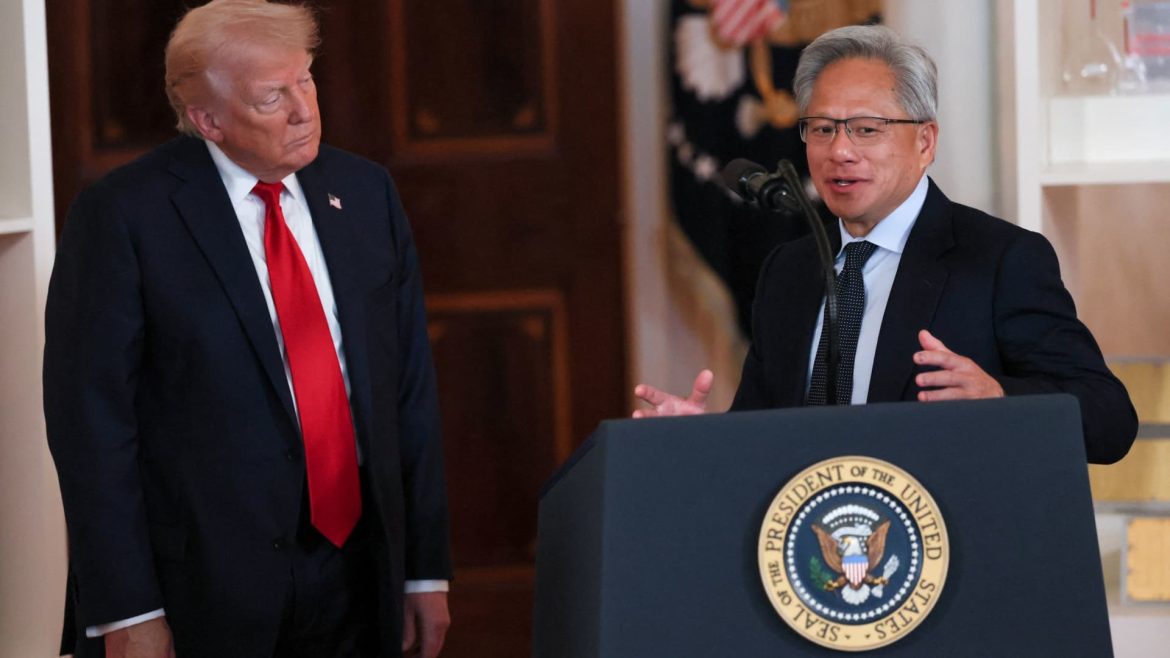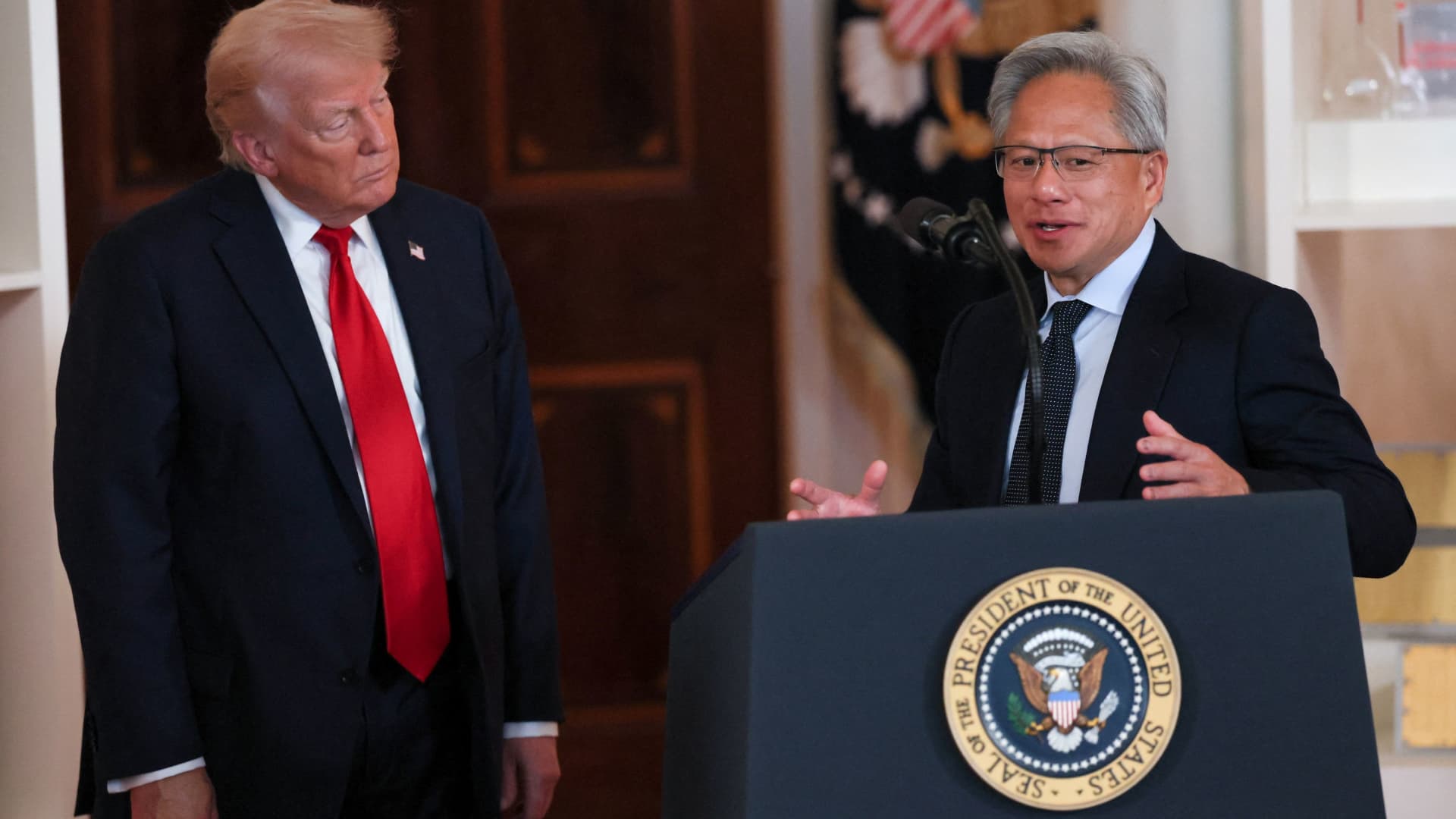Nvidia, a titan in the realms of graphics and artificial intelligence, stands at a critical juncture. CEO Jensen Huang’s recent meeting with former President Donald Trump at the White House, followed by a scheduled trip to China, underscores the intricate geopolitical tightrope the company must navigate. This comes as Nvidia briefly achieved a staggering $4 trillion market capitalization, a milestone unparalleled in corporate history. The implications of these events ripple across the tech industry, global trade, and the future of AI.
A Strategic Meeting: Nvidia and the White House
The encounter between Jensen Huang and Donald Trump is fraught with significance. While the specifics of their discussion remain private, the broader context provides insight. Trump’s well-documented focus on bolstering domestic manufacturing and technological supremacy aligns with Nvidia’s substantial investments in U.S.-based chip production. Huang has publicly emphasized Nvidia’s commitment to manufacturing the most advanced AI chips domestically, a pledge likely to resonate with Trump’s priorities.
This meeting also occurs against the backdrop of escalating trade tensions and concerns over China’s technological advancements. Nvidia’s cutting-edge chips are pivotal for AI development, and the U.S. government has been vigilant in regulating their export to China. The discussion may have centered on export controls, tariffs, and the delicate equilibrium between fostering innovation and safeguarding national security.
Trump’s history of protectionist trade policies and potential tariffs on semiconductors adds another layer of complexity. Huang’s meeting likely aimed to gauge Trump’s stance on these issues and advocate for policies that support Nvidia’s global operations while ensuring U.S. technological leadership.
China: A Market of Opportunities and Challenges
Huang’s impending trip to China introduces another dimension to Nvidia’s strategic balancing act. China represents a colossal market for Nvidia, and the company has been adept at catering to Chinese demand while adhering to U.S. export restrictions. The development of the H20 AI chip, designed to comply with U.S. regulations for sale in China, exemplifies this delicate maneuvering.
The timing of Trump’s meeting with Huang, just days before the CEO’s departure to China, suggests a coordinated effort to align Nvidia’s engagements in China with U.S. strategic interests. Huang’s visit to China is undoubtedly aimed at strengthening partnerships and exploring collaborative opportunities. However, he must navigate political sensitivities and potential risks, including intellectual property concerns, regulatory uncertainties, and competition from domestic Chinese chipmakers.
China’s leadership in AI adoption and deployment makes it indispensable for Nvidia’s growth. The country’s rapid advancements in AI, coupled with its vast market potential, present both opportunities and challenges. Nvidia must tread carefully to maintain its foothold in China while adhering to U.S. regulations and mitigating geopolitical risks.
The $4 Trillion Milestone: A Testament to Nvidia’s Vision
Nvidia’s brief surpassing of a $4 trillion market capitalization is a testament to its long-term vision and execution. This milestone is not merely a reflection of short-term market sentiment but a validation of Nvidia’s strategic positioning in key technology trends, particularly artificial intelligence.
Nvidia’s GPUs are the industry standard for AI training and inference, and its software platforms, such as CUDA, are essential tools for AI developers. The surging demand for AI across industries—cloud computing, autonomous vehicles, healthcare, and finance—has driven Nvidia’s growth. Diversification into data centers, automotive, and professional visualization has further strengthened its resilience.
Analysts predict continued growth for Nvidia, citing the sustained AI boom and the company’s competitive edge. Some even speculate that Nvidia could be among the first to reach a $5 trillion or even $10 trillion market cap in the coming years. This growth trajectory underscores Nvidia’s pivotal role in shaping the future of technology.
Navigating the Future: Challenges and Opportunities
Despite its remarkable success, Nvidia faces significant challenges. Competition is intensifying, with AMD, Intel, and startups vying for a share of the AI chip market. Geopolitical tensions could disrupt supply chains or limit access to key markets. Rapid technological advancements could render current products obsolete if Nvidia fails to innovate.
However, Nvidia also has substantial opportunities. The demand for AI chips is expected to grow exponentially, and Nvidia is investing heavily in R&D to stay ahead. Its strong brand reputation and established customer relationships provide a competitive advantage.
The AI Imperative: A World Transformed
Nvidia’s story is intertwined with the broader AI revolution. As AI reshapes industries and society, Nvidia’s role as a key enabler of AI technology becomes increasingly critical. From powering self-driving cars to enabling breakthroughs in drug discovery, Nvidia’s chips and software are central to AI-driven innovations.
The AI revolution presents immense opportunities and significant challenges. It has the potential to enhance productivity, create new jobs, and address global problems. However, it also raises concerns about job displacement, algorithmic bias, and the ethical implications of AI-powered weapons and surveillance.
Conclusion: A Pivotal Moment for Nvidia and the World
Nvidia’s journey—marked by a high-stakes meeting with Trump, a strategic trip to China, and a $4 trillion market cap—highlights the complex interplay between technology, geopolitics, and economics. The company’s success reflects not only its technological prowess but also its ability to navigate a rapidly evolving global landscape. As Nvidia continues to push the boundaries of AI and shape the future of technology, its actions will have far-reaching consequences for businesses, governments, and individuals worldwide. The stakes are high, and the world is watching.





